Kabuli Burgers: Afghani Street Food from Pakistan
How does the old saw go? “What do you call English muffins in England?” The answer is that you call them muffins, of course, though some people think crumpets are the same thing (they are not). In Canada, Canadian bacon is called back bacon or peameal bacon (if it’s rolled in peameal) or just bacon sometimes. There aren’t really any hard rules when it comes to referencing food items named after places though. In America we call American cheese, well, American cheese, but there are hundreds of different cheeses and people would get confused if we didn’t. Turkish Delight is lokum in Turkey, which derives from an Arabic word meaning “throat”; Swedish meatballs are köttbullar in Sweden (which basically just means “meat buns”–close enough). In Belgium, Belgian waffles are not simply known as “waffles” because Belgium has different kinds of waffles–they are differentiated from stroopwaffels as “Brussels waffles.” I’m not sure what they call Brussels sprouts in Brussels but I imagine it is something along the lines of “tiny cabbages that we invented like hundreds of years ago.”
So what do they call the Afghani Burger in Afghanistan? The Kabuli Burger in Kabul? Afghani burger and Kabuli burger are 2 different names for the same street food, said to be popularized by Afghan people living in Pakistan’s capital city of Islamabad and nearby Peshawar. But did it really originate in Pakistan rather than Afghanistan? And if not, what do they call it?
Well there’s this video from Afghani Ariana Television in which at least the English translation refers to the wrap as a “Kabulian burger.” The phone numbers on the sides of the food stand have an area code that indicates either that this is in Gardez, Afghanistan or that, more likely, they are mobile numbers issued by Afghan Wireless.
Here is another video showing the wraps–referenced as “Afghan Burgers”–being prepared by Pakiza Burger, a restaurant in Kabul.
So you can get one of these Afghani burgers in Kabul, in which case it truly is a Kabuli burger. They seem to serve these wraps in Jalalabad as well. You can get an Afghan Burger in Mazar-i-Sharif. The “special burger” they serve in Herat is, recognizably, much closer to a Western-style burger, and I can’t find any indication of anything called a burger in Kandahar. But they do appear to be relatively widespread in Afghanistan itself, and generally called Afghan or Afghani or Kabuli burgers there.
It’s funny to us here in America to see what is essentially a wrap called a “burger”–we invented the hamburger, after all, and we are protective of it, side-eyeing even those people who depart from the standard condimentation of an American burger, like those antipodeans with their beetroot and pineapple. (It’s mayo/ketchup/pickle/onion/tomato/lettuce/mustard and don’t you forget it, weirdos!) But like with China’s donkey burger, another flatbread sandwich that definitely does not fit our conception of what a burger should be, it’s not up to us to police how our pop culture exports are received and filtered by other cultures around the world. It’s as pointless as arguing whether a hamburger itself is a sandwich. (It is, so is a hot dog, next topic.)
In Afghanistan, in Pakistan, a burger–that is, an Afghani burger–is a wrap. It is served in soft “naan paraki” or chapati flatbreads that appear to be sliced into rectangular sections after baking. The fillings may include deep-fried sausages made with chicken or beef but not pork–we might be tempted to call them hot dogs, though that is not generally how I have seen them referenced in my research–or roasted chicken, sliced or shredded, or possibly some variety of kebab; with a salad of shredded cabbage, cilantro, onions, tomatoes, and cucumbers; boiled eggs; French fries; chaat masala; and a variety of sauces that might include mayonnaise, ketchup, and mint or tomato chutneys. Only in Western restaurants offering “Afghan Street Food” have I seen them referred to as “wraps,” to cater to our odd notions of burger propriety.
In the Chicago area, you can find a wrap something like this at Afghan Kabob on Dempster Street at Austin Avenue, just a bit outside the city. Formerly located on Montrose Avenue in the Mayfair neighborhood of Chicago’s Northwest side, Afghan Kabob relocated about a year ago to Morton Grove, home of foodie favorite Burt’s Place.



We drove to Morton Grove after work one day, a bit of a haul during rush hour, unsure of what to expect and prepared to make the best of an in-car meal. Once we arrived, the cleanliness of the restaurant and the isolated, well-lit table near the window felt like a good sign, and the staff let us know we’d be welcome to stay as well. The interior strikes a balance between a sort of pristine formica fast-food sheen with some homier touches, such as a (currently closed off due to Covid) Afghan seating area, hanging rugs and tassels and all manner of wall decorations. Their menu has a broad selection of Afghan foods that can be ordered counter-service style for dining in, and there was steady traffic of pickup orders as well. Still, for the most part during our hour in the restaurant, it was just Mindy, Ian, and myself in that dining room.




Meat dumplings called mantu and leek-stuffed dumplings called aushak were both served similarly, topped by a pair of sauces: a savory and bright red “meat sauce” that seemed like a tomato-and-meat ragout without the meat, instead studded with firm al dente lentils; and a garlic and yogurt sauce, garnished with dried mint. The meat dumplings were good, but Ian and I were surprised to find ourselves liking the mellow flavor and soft texture of the leek dumplings a bit better. We also ordered a “lamb karayee,” which I took to be a similar word/dish to Pakistani karahi, but which the lady serving us pronounced “curry,” a connection that I had honestly never previously made that is likely coincidental. The karayee was bone-in lamb stewed with tomatoes and herbs. It was fatty, salty, and intensely savory, and was served with dill-flecked basmati rice; an Afghan salad consisting of cucumber, tomato, onions, herbs, and lemon juice; and Afghan bread, which in this case was sliced sections of something slightly thicker and darker-grained than the naan I’d expected. I’d go back just for this dish, though I do hope to explore more of the menu one day.
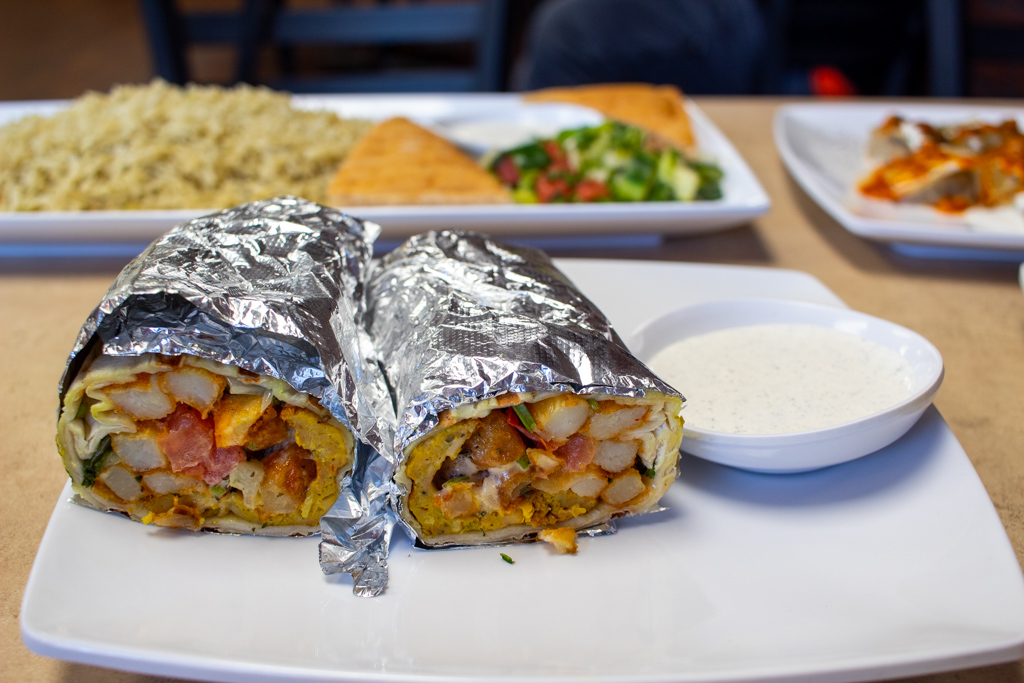
Of course we were there–or at least I was–to try the wrap, which was served in foil and sliced in half alongside a small dish of the minty garlic/yogurt sauce. This shami kebab was a patty of minced chicken, though they have a beef variety as well, mixed with spices, bound with chickpea flour, and fried in oil like the similar Afghani dish chapli kebab. It is wrapped tightly in a thin flatbread with thick-cut fries. There is some manner of salad included as well, and sauce, but the main impressions are of the soft mildly spiced chicken, the solidity of the fries, and a slight minty/herbal freshness from the salad.
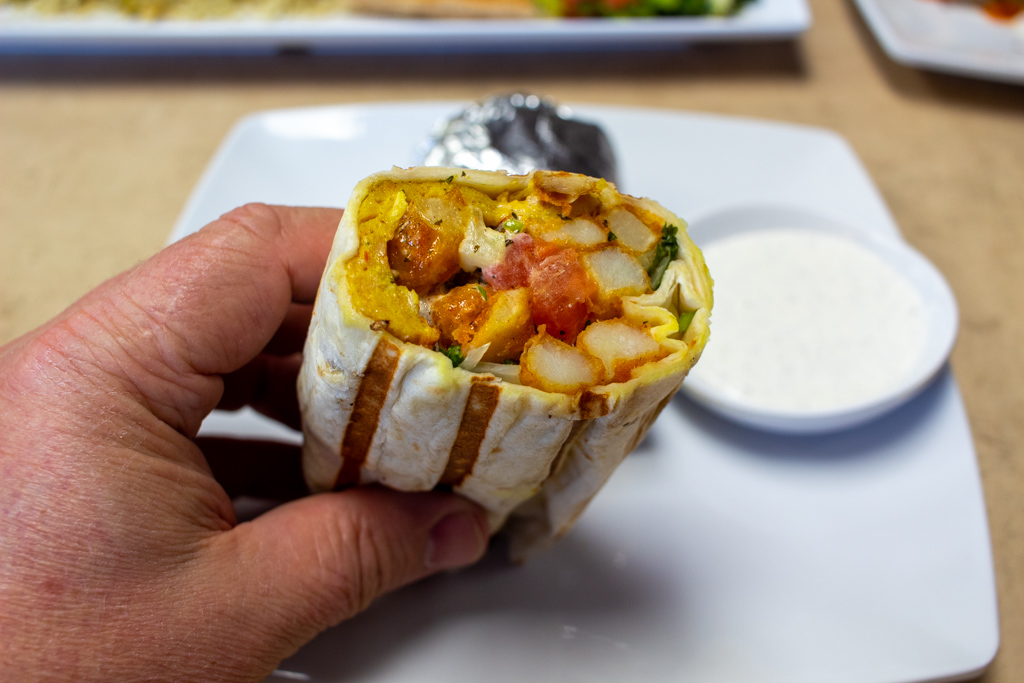
It’s a good wrap, and I enjoyed it. But I’m not seeing the boiled egg, and I’m not seeing the shredded cabbage, and I don’t feel like I’m getting the actual “Afghani Burger” experience doing things this way.
Does it count as street food if I make it at my house?
Cobbling Together a Burger
Any great sandwich starts with the right bread, as I always say, and the right bread for this sandwich is a thin flatbread called naan paraki, a kind of chapati. The stands that sell Afghani burgers in Afghanistan and Pakistan appear to be using rectangular sections of bread, as if cut that way after baking, and doubling them up to make a slightly thicker, larger rectangle, something like 5″ x 10″ perhaps, or 6″ x 12″. It does appear to vary slightly from place to place. This Youtube video, which is in another language (Dari perhaps? The Persian language spoken by most Afghanis) but is well-translated into English in the Subtitles (use the CC button at the bottom of the video if you’re unfamiliar), has good instructions for making both the puffier, seeded version of Afghani naan (khasa) and the thinner version we’re using here.
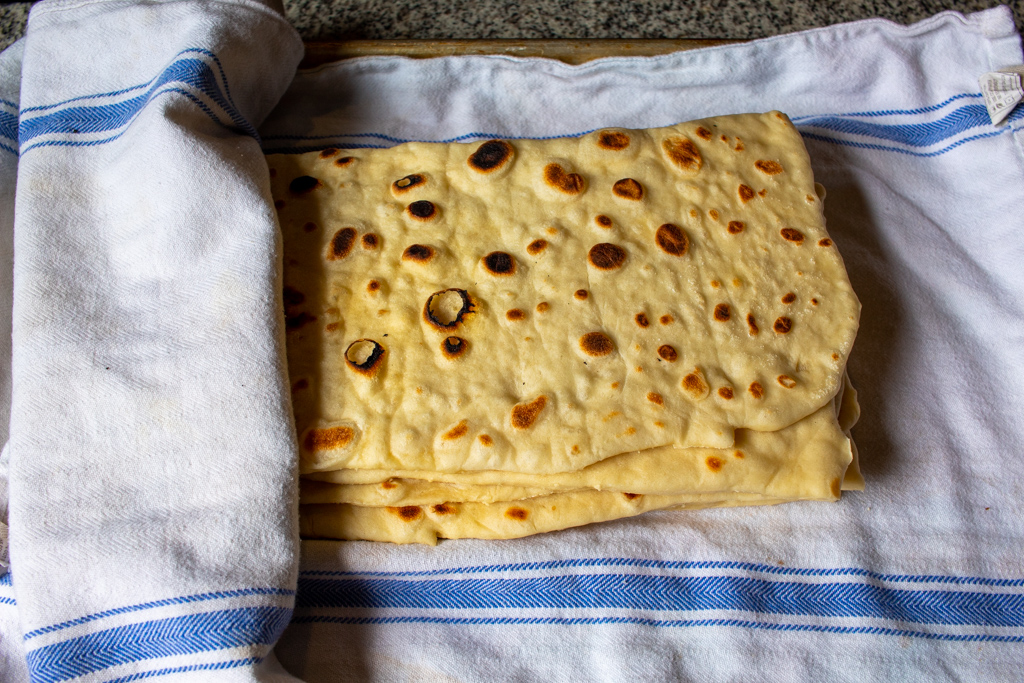
I didn’t get these rolled out quite thin enough I think, but they were flexible enough to use for a wrap and the stands often double them up anyway. I rolled them out quite long and then cut the dough into rectangular sections before baking it on a hot cast iron griddle.
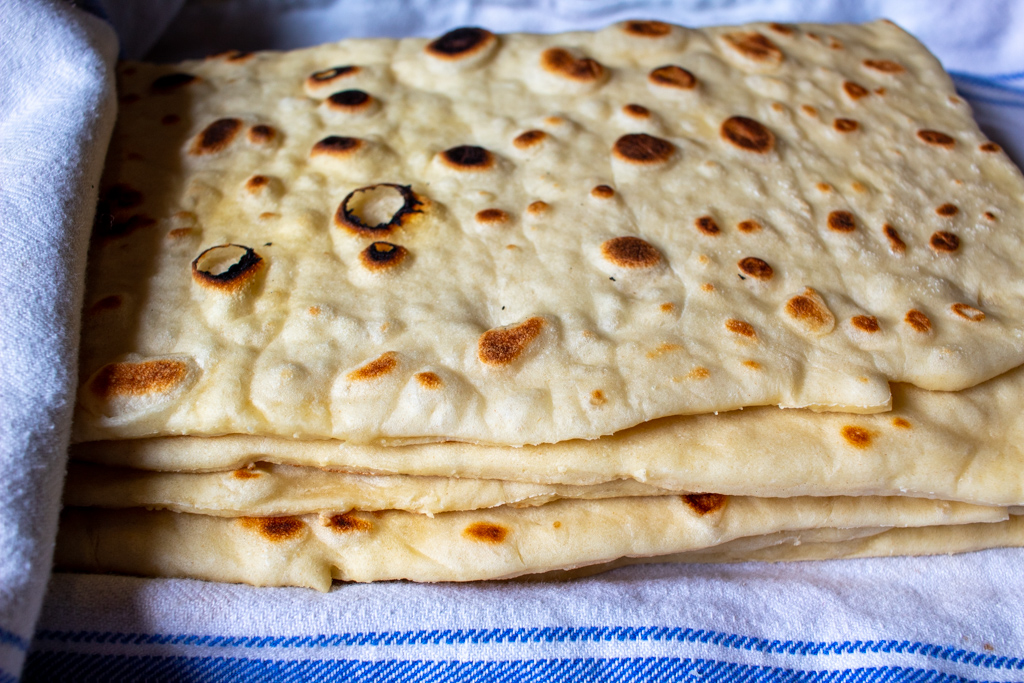
For the remainder of my mise en place: some halal chicken sausages that look very much like hot dogs; chicken thighs marinated overnight Afghan-style in yogurt, garlic, ginger, grated onion, cumin, lemon juice, and some kashmiri chili powder before being grilled over charcoal; chapli kebabs, minced beef mixed with flour, egg, finely-diced tomato, onion, cilantro, and finger chilies, coriander, turmeric, allspice, kashmiri chili, and salt, formed into patties, and fried in oil; French fries; a salad of shaved cabbage, red onion, and chopped cilantro; thin slices of tomato and cucumber; hard-boiled eggs; chaat masala; mayonnaise; and a homemade tomato chutney that was very much like a runny fresh salsa but with a hint of minty sweetness.




We start with one of my vaguely rectangular naan parakis, looking for all the world like a bready model of, say, North Dakota, or one of those vaguely rectangular plains states anyway.

We spread the salad mixture liberally over the surface of the flatbread, then top it with cucumber slices, a slice of tomato, chaat masala, tomato chutney, and a thin bead of mayonnaise.
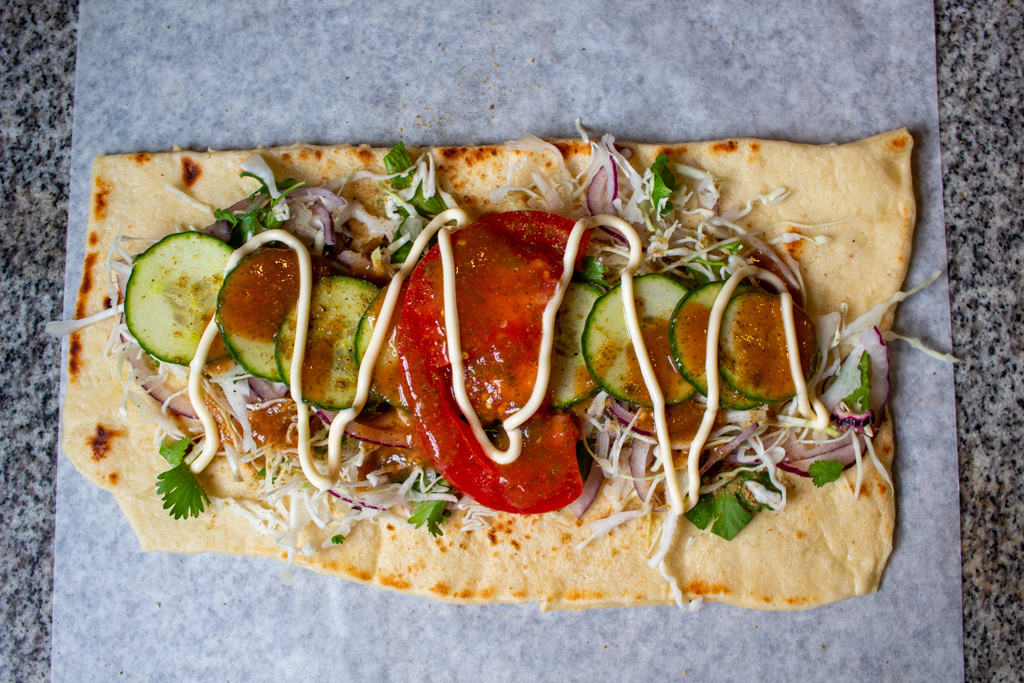
For this burger we’re using a chicken sausage, along with roughly half a hard-boiled egg.
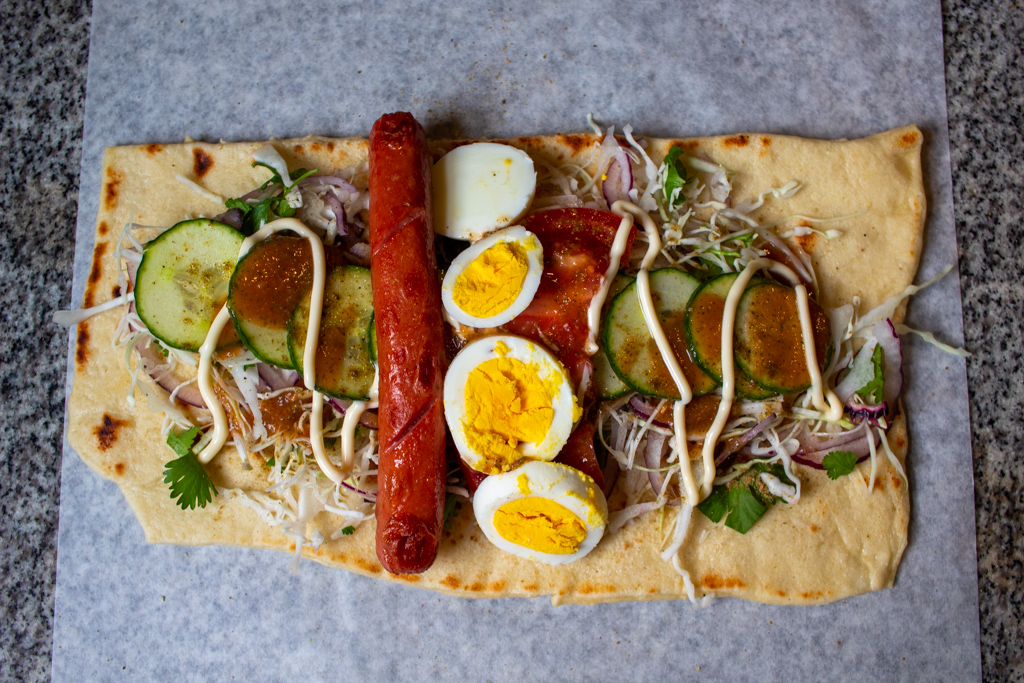
And on top, a big, double-fistful of fries. More than I used here, probably. As many as you think you can stick on there and still get the bread wrapped around it, or at least that’s the way they seemed to do it in the videos. Wrap it up tight, then wrap it again with some paper–I’m using wax paper here, but that is a little flimsy for this purpose–and tuck the paper under the bottom to keep things from falling out, at least for the first couple of bites.
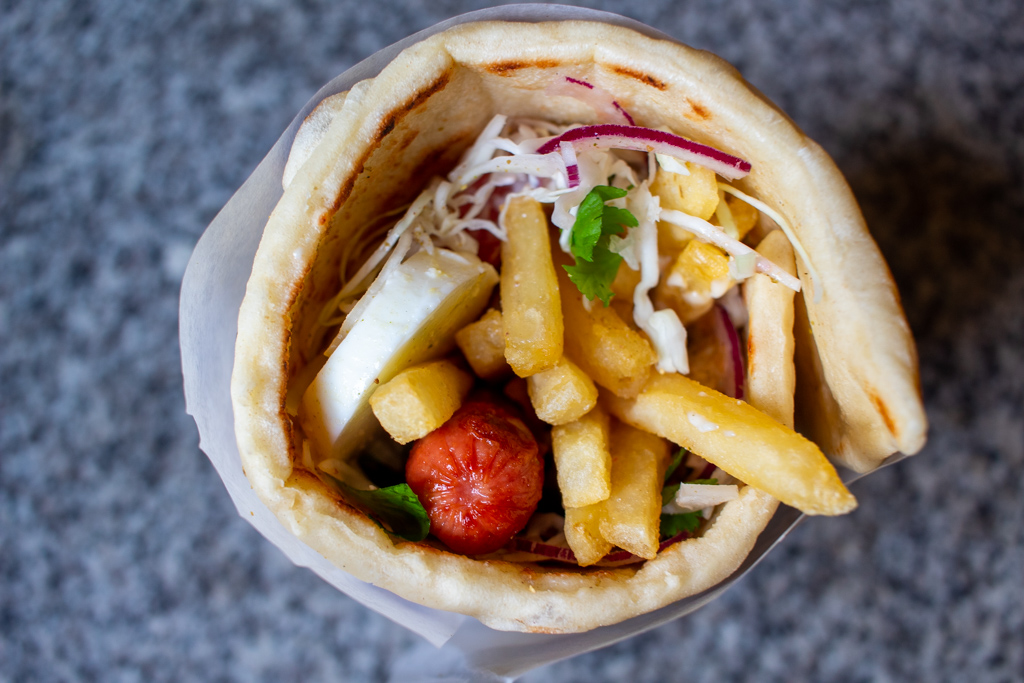
Not surprisingly, this is quite good. The chicken sausage is a cheap extruded forcemeat and in another setting I would not be a fan but it is an ensemble player here, partnered with the egg but sharing the billing with the crisp, warm fries, the familiarly slawlike but still different salad resulting from the cabbage, onion, and cilantro mixture being in close proximity with the chaat masala, mayonnaise, and tomato chutney. Even the bread, which ought only to be holding this ticking timebomb of a shirt disaster together, contributed its own notes, the charred bubbles from cooking on the griddle, the faint taint of yeast leavening. I don’t often like carb-on-carb sandwiches, but perhaps because this is a wrap, or perhaps because there are so many different textures in each bite, the fries are a strength, not a liability.

I had made too much of the cabbage mixture–about 1/2 a head of cabbage, sliced thin on a mandoline, and a good-sized red onion sliced thin as well mixed with about half a bunch of cilantro, large stems broken off and the remaining leaves and stems roughly chopped together. In days following, I would make a little slaw with this mix, some kewpie mayo, and tomato chutney, and serve it alongside whatever sandwich or taco or plate of leftovers I was having for lunch that day. It worked with everything, and it was delicious every time.
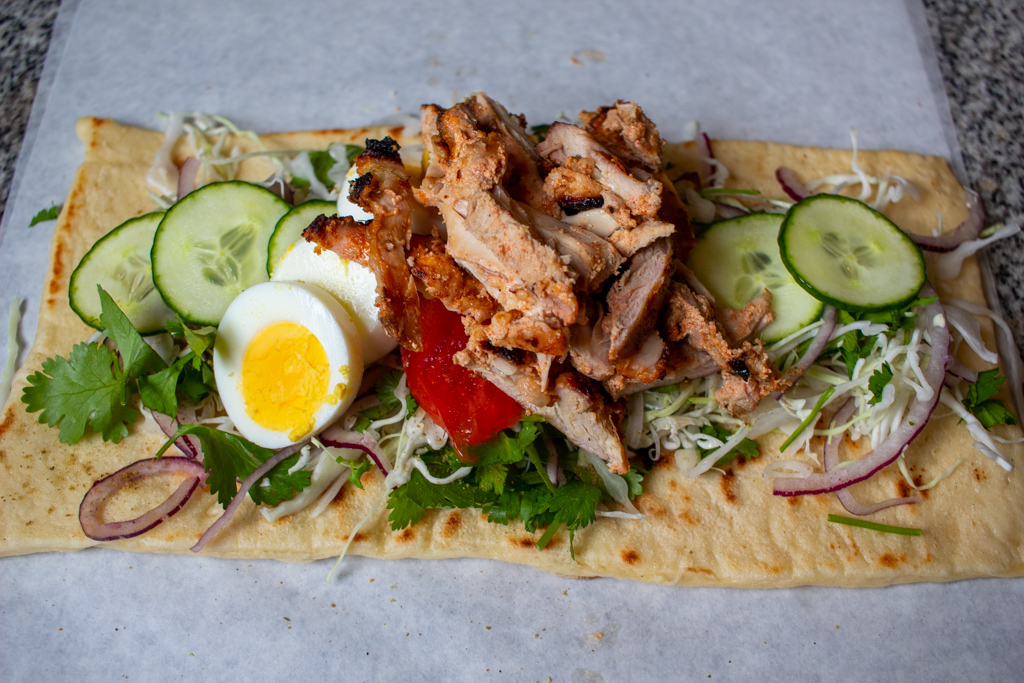
The murgh or Afghan chicken is a recipe that we’ll make again. It’s a bit spicy–I could tone down the amount of kashmiri chili I used, but neither Mindy nor Ian complained and if it ain’t broke, etc. Again, I had made too much of it, but it did not go to waste. We made naan pizzas with it, with tomato chutney and a mozzarella/provolone blend. We mixed it into instant ramen, or macaroni and cheese, or bagged salads from the store. Again, this was a surprisingly universal ingredient.
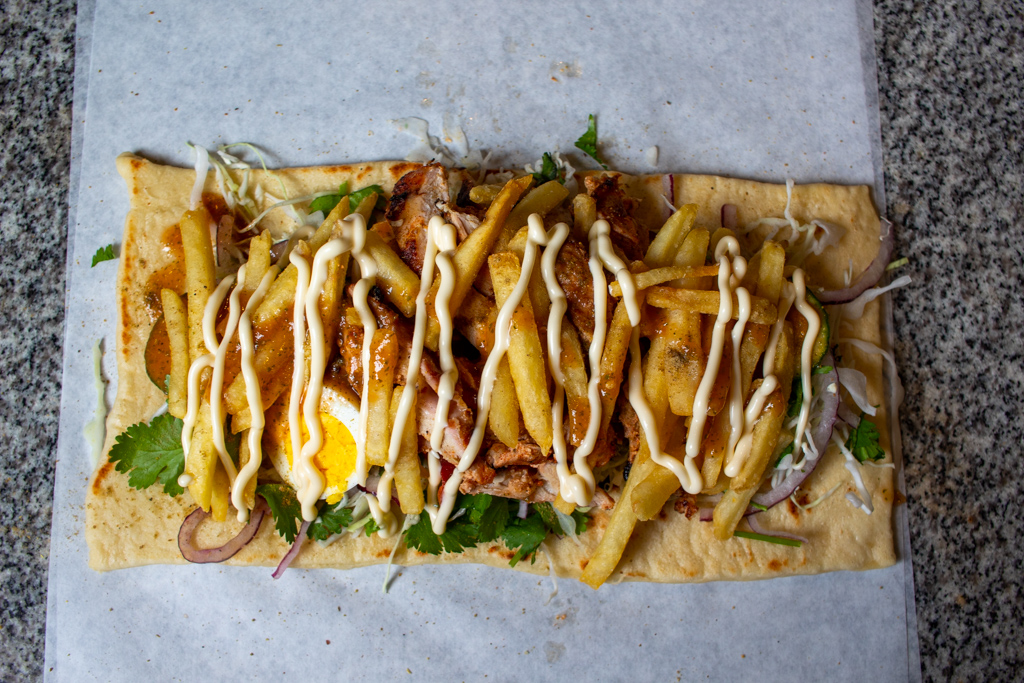
It really shone in the Afghani burger though. The chicken was rich with flavor but not salty the way that the sausages had been, instead featuring the cumin, the ginger and garlic, and most of all the welcome flavor that charcoal-grilling brings. It felt more like a kebab than the hot dog filling had.

The wax paper, even a double layer, was just not strong enough to contain these wraps though, and I started adding aluminum foil as well, which also helped maintain their shape.
The last filling I tried was the chapli kebab. I have not actually seen any evidence that this is commonly used as an Afghani burger filling but if you search for the term “Afghani burger” and look inbetween the hits featuring this wrap, you’ll see the chapli kebab mentioned. It’s Afghan food, it’s ground beef in a roughly circular patty–it’s kind of an Afghani burger, sure, though not the Afghani burger we’re after this month. Unless…

I forgot to put the boiled egg into this burger, unfortunately, but I don’t think it suffered as a result. The chapli kebab patty was spicy, salty, bright and warm and mouthfilling, especially with its blanket of fries.
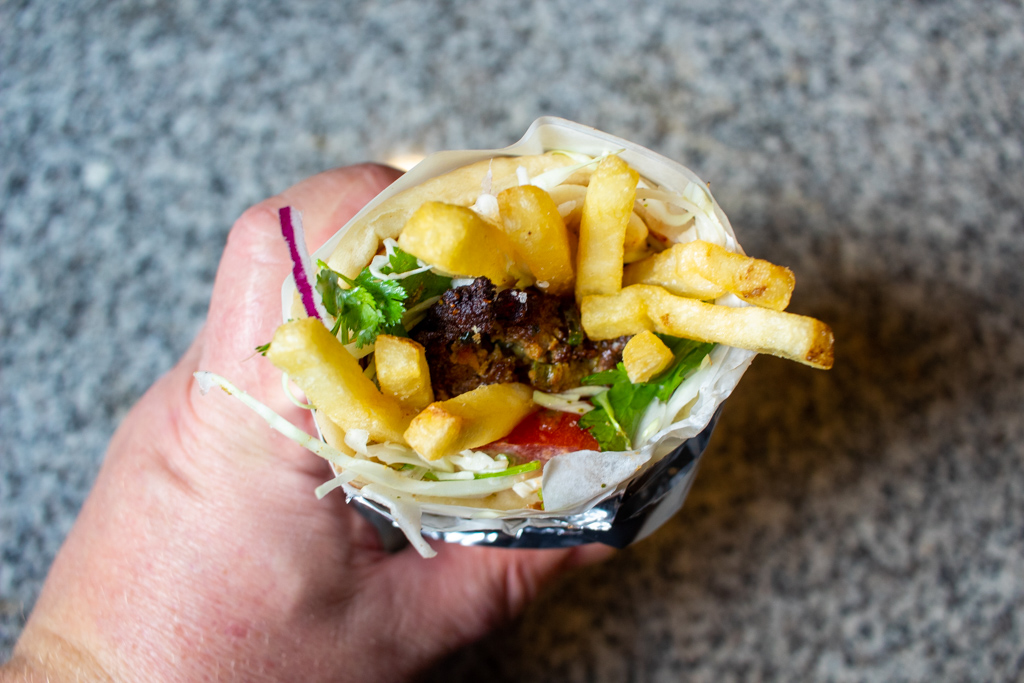
Chapli kebab, wrapped in naan, with onion, tomato, chutney, and fries? This seems like a pretty typical kebab wrap that might be served anywhere. In fact it’s almost identical to the chicken shami wrap I had at Afghan Kabob. How did Afghanis come around to calling this a burger again?
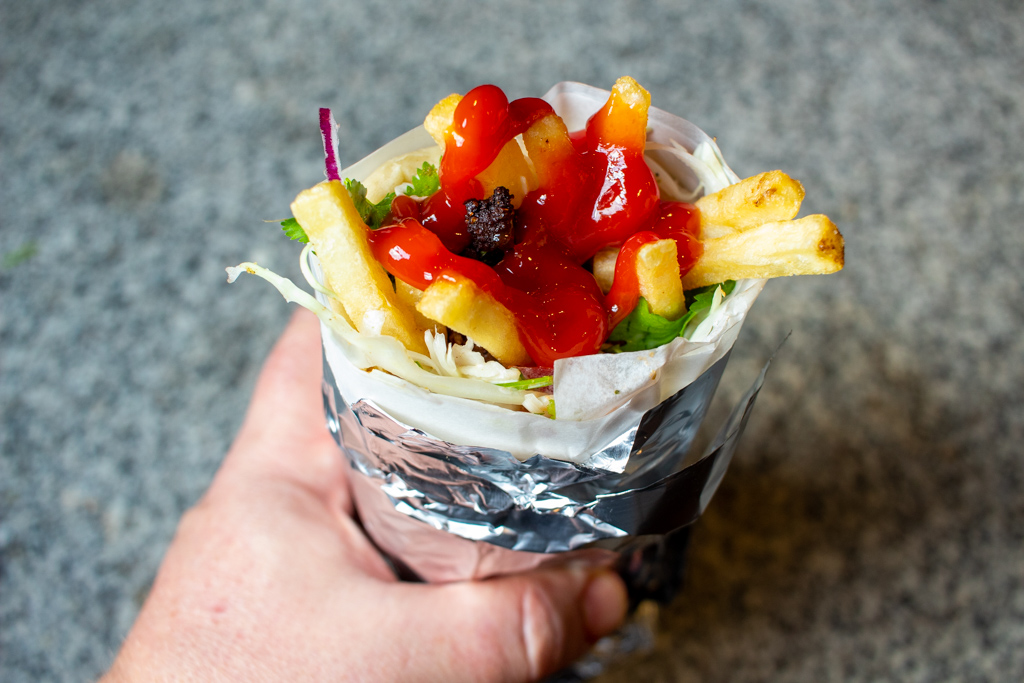
They call it a burger because that is a Western fast food archetype, because of the pervasive influence of Western culture, because it sells burgers. Who knows? Why don’t we see it sold as a burger in the US, in Canada? Because we wouldn’t get it? Because of the never-ending stream of actuallying burger nerds who’d blow in their doors carrying Venn diagrams and raging about food taxonomies? Because we, in fact, are giant precious baby idiots? Maybe. Maybe it’s just easier to call it a wrap here and a burger there. I’m not as fussed about the name as long as it tastes good, and an Afghani burger does that.

I like sandwiches.
I like a lot of other things too but sandwiches are pretty great











discovered your guys’ blog by accident because i was googling korokke pan! i’ve read a couple of posts, what a fun project 🙂
gives me old-school internet vibes, like y’all have put a lot of heart and steady maintenance into this. i’m pakistani, so it’s cool to see a “sandwich” sold in pakistan on here <3
Thank you for the comment! Super glad to hear you like the site, and I hope I did justice to the Afghani burgers!